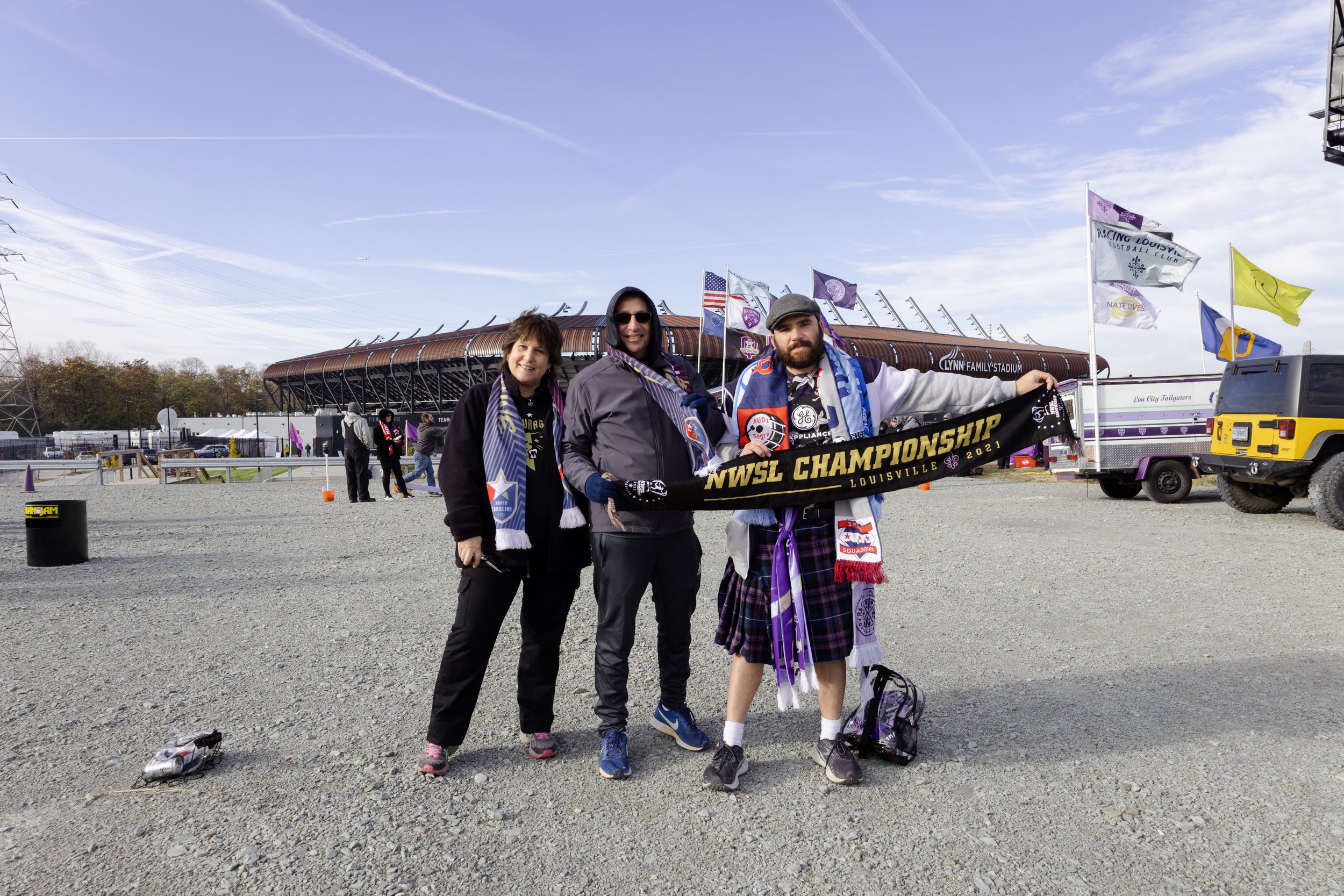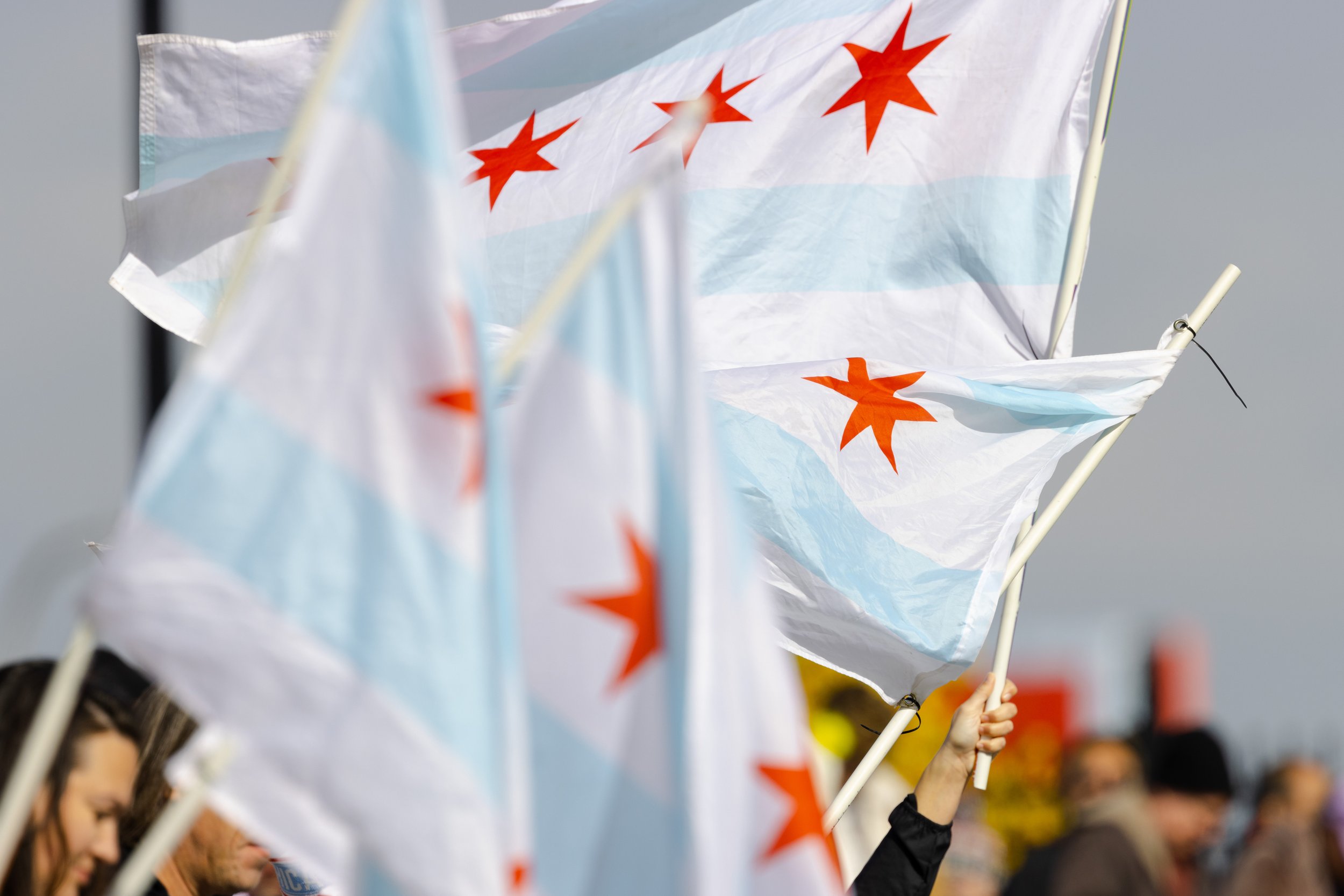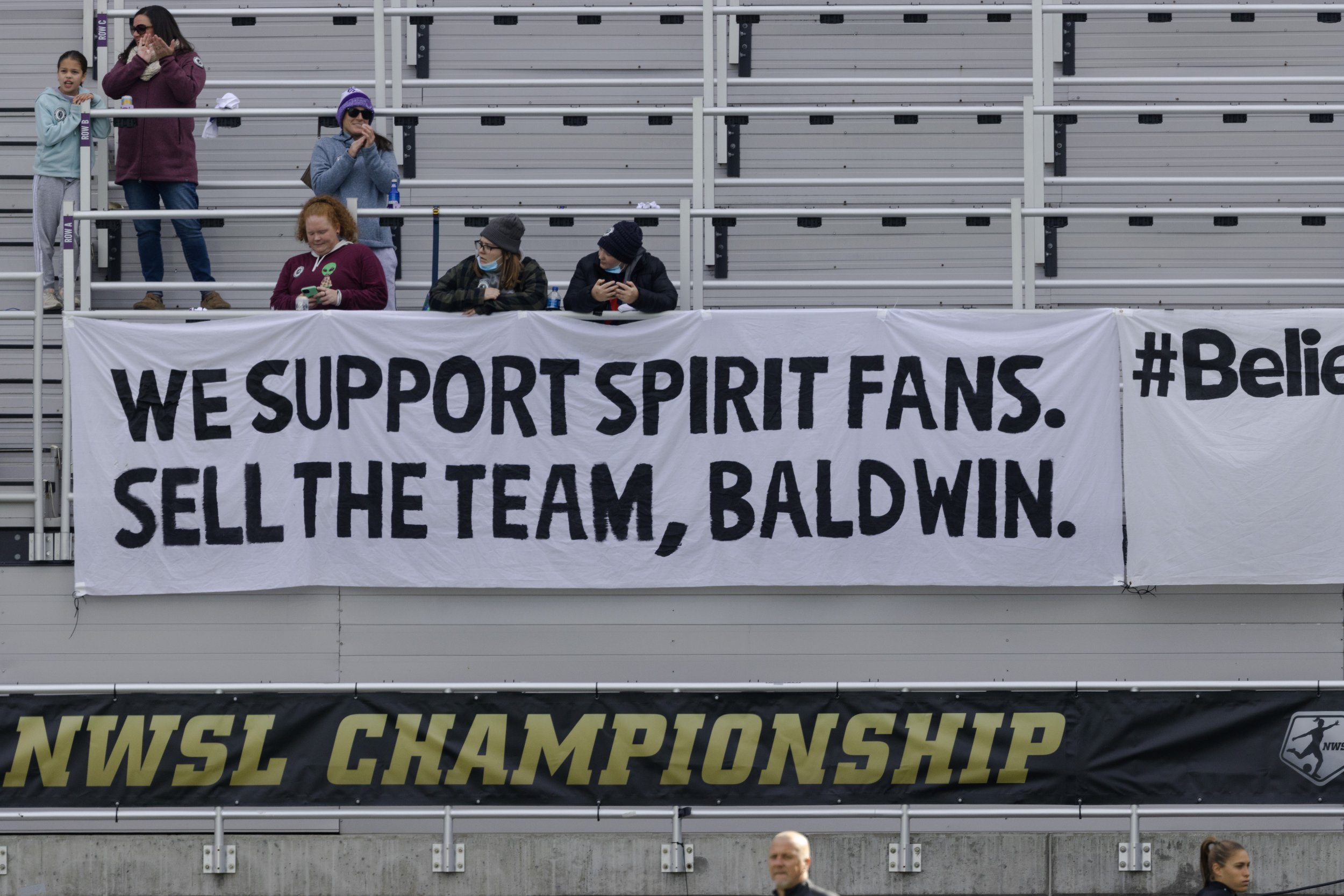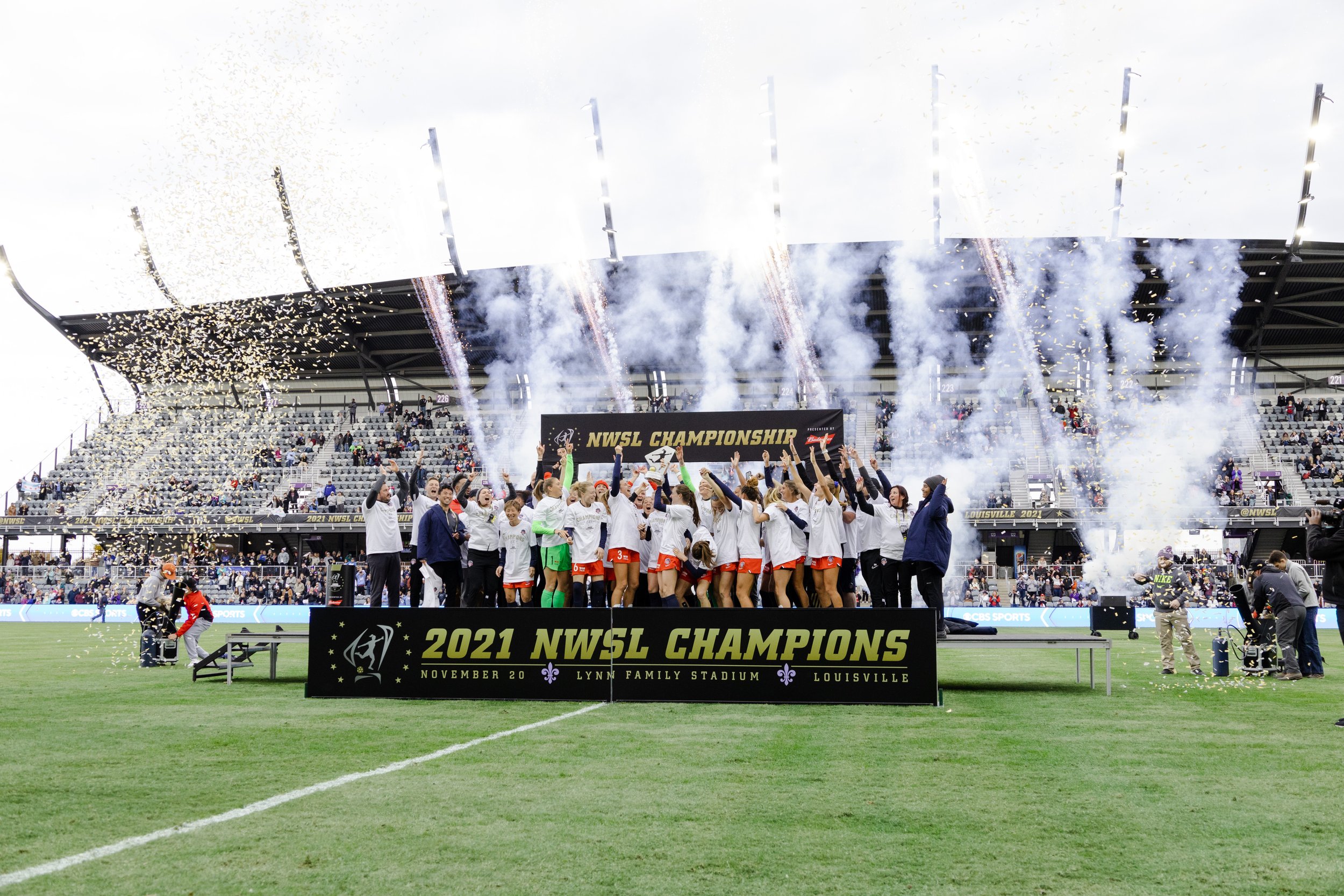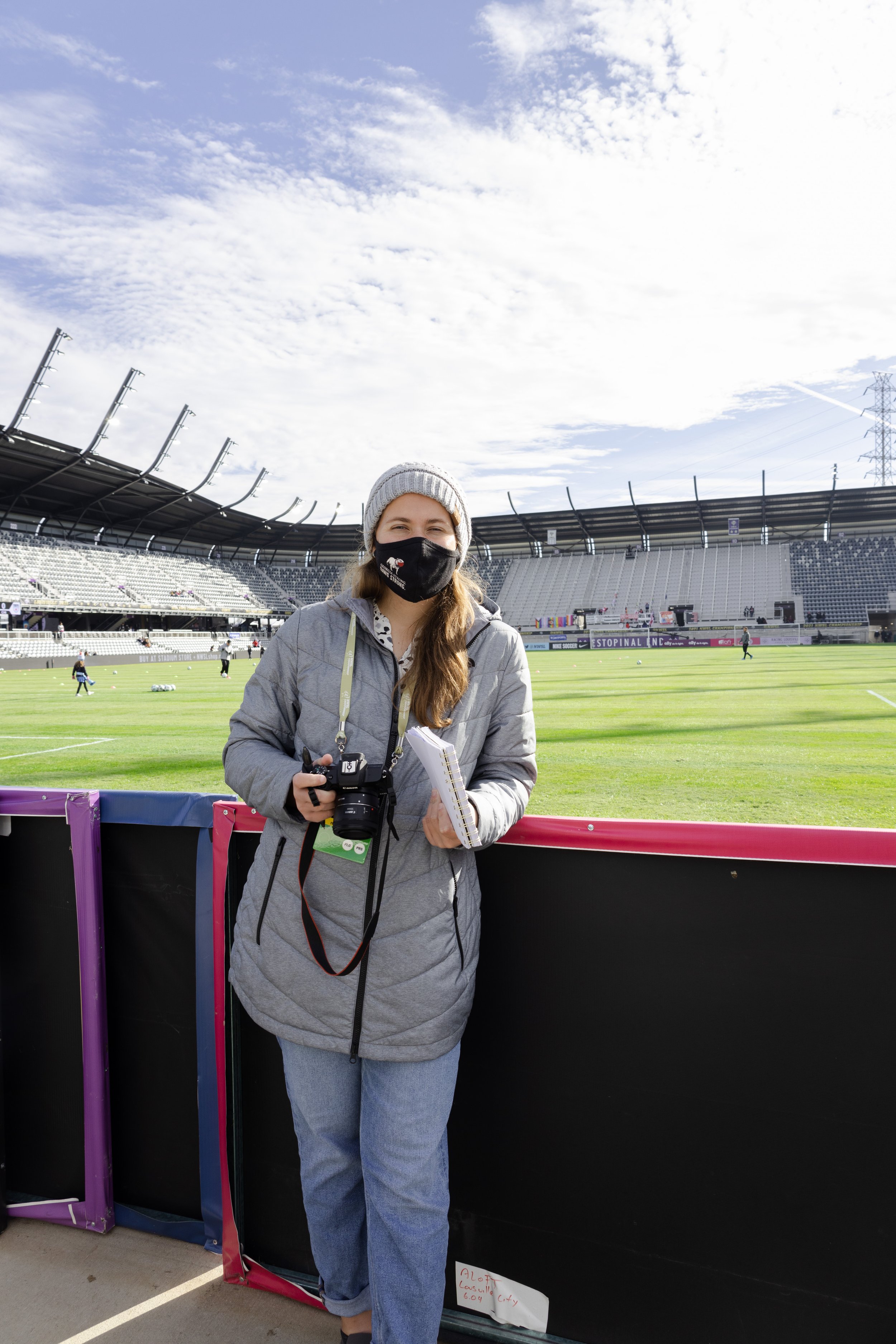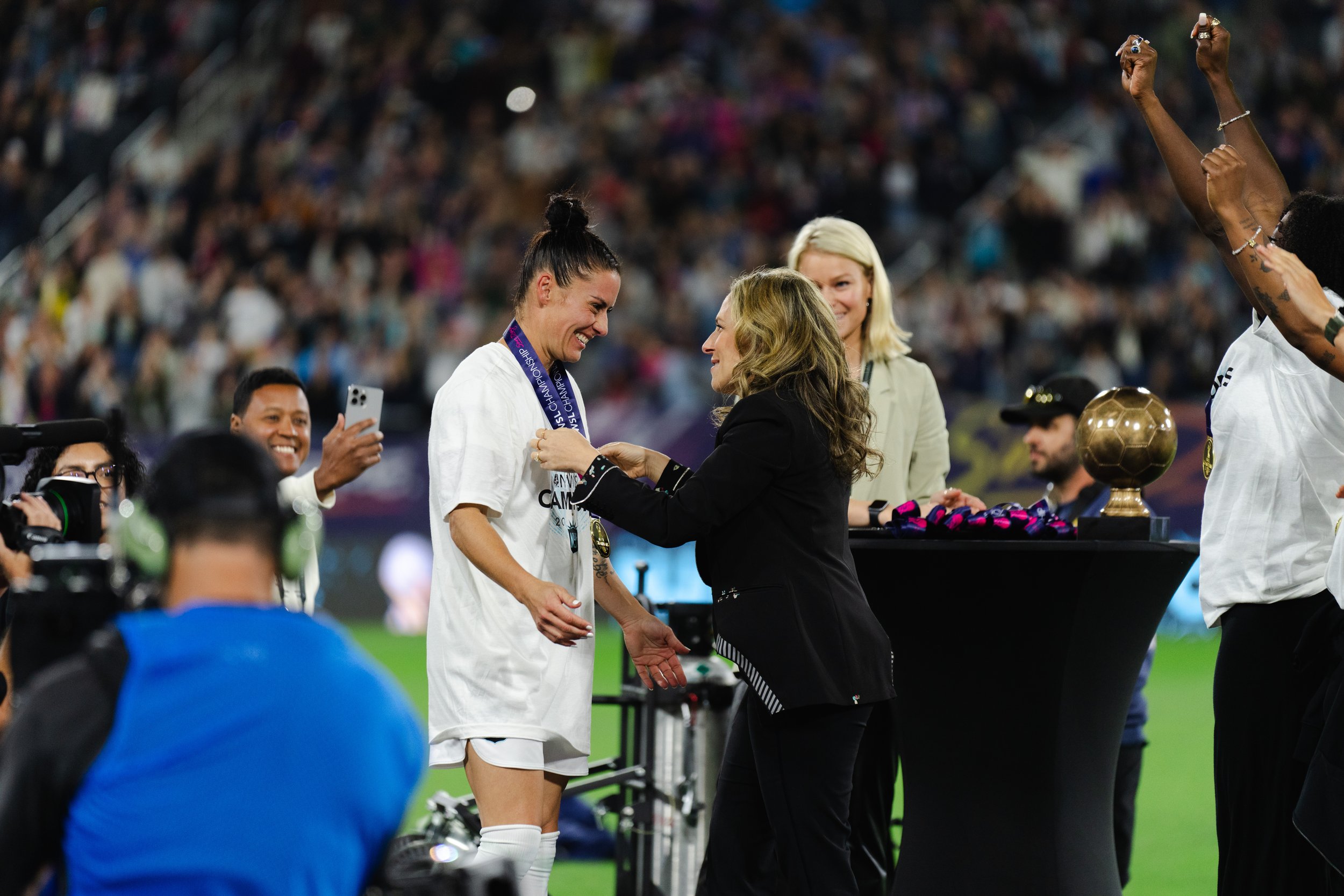Change

Something old, something new, something in-between: observations from a trip to the 2021 NWSL Championship
The bus is very purple. A bright, rich purple, like the color of Grape Fanta, matte all over. It’s a bit bigger than an ambulance, about the size of a small school bus. It smelled like pancakes and coffee-- not the bus, but the tailgate around it, where I stood with photographers Dave and Rachel in the crisp, chilly morning air.
In the gravel parking lot outside of Lynn Family Stadium in Louisville, Kentucky, on the morning of the 2021 NWSL championship, a Racing Louisville fan explained to me the origins of this vibrant purple automobile.
The Louisville supporters’ group originally had a small trailer, shoulder-height or so, that they dragged behind someone’s car to the Louisville City FC USL games and, now, the Racing Louisville games as well. They’d unload the tents and tables and set up their tailgate-- sometimes as early as 6 a.m. They’d rolled into the parking lot around that hour, too, the morning of the NWSL championship, November 20, 2021.
It was around 9 a.m. by the time I stopped by their tents; the group of ten or so fans was well settled in, folding tables bearing donuts, pancakes, hot chocolate, coffee, and a wide variety of alcohol. Several fans played cornhole.
That small trailer, the fans told me, had been upgraded to a larger trailer, still towed behind a car. Then both trailers, towed along. But then, as the tailgate group grew, with more supplies and more people, they needed to upgrade—something bigger, something more eye-catching.
Thus, the bus.
It has the Racing Louisville and Louisville City FC logos on the windows, plus markings for the trophies the teams have won since LouCity’s 2014 inception and now Racing’s 2021 inaugural season. With the back door open, we could see the supply shelves inside. Louisville team flags fluttered in the wind on tall, wobbling poles planted around the bus. It was a routine setup, a staple at the Louisville games-- but it was the first time that it was there for Louisville’s turn at hosting the NWSL championship.
Throughout the weekend, while I was taking notes on the game between the Washington Spirit and the Chicago Red Stars, I thought of that bus and the trailers that had come before it. Why? A valid question-- I was surprised, too. The bus wasn’t connected to the teams that were playing in the championship in any way, or to the larger context of the NWSL season as a whole. But-- I kept thinking about the idea of the first trailer changing into a larger trailer, changing into a bus. Growth, and change, but also a sort of legacy, tied to the longstanding supporters’ traditions.
It’s through that lens that I want to look at my time at the NWSL championship and the stories, coverage, and weekend surrounding it: some things that are older, with a sense of legacy; things that are new and different; and things that are in-between, in a state of change.
Something new: a first NWSL Championship for the Washington Spirit
The Spirit’s 2-1 extra-time win over the Chicago Red Stars was Washington’s first-ever NWSL championship title-- it would have also been the Red Stars’ first title, should they have won. Since the league’s inception in 2013, the Spirit had competed in one prior final, in 2016, but fell to the Western New York Flash in penalty kicks.
Both Washington and Chicago had upset the higher-seeded teams, OL Reign and Portland, respectively, in the semifinal matchups, booking their trips to the championship game.
Solid defensive plays from players like Emily Sonnett, Sarah Gorden, and both teams’ back lines kept the score at 0-0 until Chicago’s Rachel Hill scored with the final kick of the first half to put the Red Stars up 1-0. Spirit midfielder Andi Sullivan equalized in the 67th minute with a penalty from a foul on Tara McKeown. The teams headed into extra time tied 1-1.
In the 97th minute, a lofted cross from forward Trinity Rodman, released from outside the eighteen, found the head of defender Kelly O’Hara, who buried the header for the game-winning goal and her first goal of the season. Late into the second half of extra time, a big save by goalkeeper Aubrey Bledsoe-- whose 30th birthday was the day of the championship-- preserved the lead for the Spirit until the final whistle blew.
Rodman, giving her thoughts on the team’s switch-ups for their comeback in the second half, said, “We were moving the ball really quickly, finding those spaces, pulling the defenders out” and opening up space central to create the early second-half chances that shifted the momentum and put the Spirit ahead. She also provided a detailed walkthrough of her game-winning assist, recounting her recognition of the lack of space to dribble inside, then the Spirit players marked on the near post run, then seeing Kelly on the back-post run and going for the cross.
Rodman’s cross. O’Hara’s goal. Later, Bledsoe’s save. Stops by the Spirit’s back line. The final whistle. At last, victory.
I was over on the Spirit supporters’ side of the pitch during extra time; most of the reporters and photographers had flocked over to that side in case the game went to a penalty shootout. Though I missed seeing the winning goal up close, I got to hear the Spirit fans chant, “When I root, I root for the Spirit,” and “Vamos Spirit, esta noche.” They brandished posterboard signs that said, “#2 Rodman, #1 Rookie” and “Saucy Sonnett,” the latter written in the style of the Waffle House logo to harken back to Emily Sonnett’s Georgia roots.
The Spirit’s championship title came after a tumultuous season for Washington, which saw their head coach fired after an investigation into his verbal and emotional abuse and racially insensitive comments towards Spirit players, then player and fan demands for majority owner Steve Baldwin to sell the team to co-owner Michele Kang, on top of the league-wide reckoning of abuse by coaches and the league’s failure to address these issues. (More context of the Spirit’s season and the league’s past several months can be found in Club Eleven’s interview with Spirit player and NWSL Players Association president Tori Huster.)
As the Spirit players lifted the NWSL trophy for the first time, with Sullivan at the center of the group, they did so with the NWSL Goalkeeper of the Year, Bledsoe; NWSL Rookie of the Year, Rodman; and NWSL Golden Boot Winner, Ashley Hatch. With the exception of two matches forfeited due to COVID-19 protocols, the team hadn’t lost a game since August under interim head coach Kris Ward.
At the post-game press conference, Ward spoke about the team’s decision to increase their tempo and push higher into Chicago’s space in the second half, then the calm nature of the group going into extra time. “[The team had] that shared purpose,” Ward said. “We want to go, we don't care what's being thrown in our way… [The players] just continue to work day in and day out, and I'm just really happy for them. More than anything, I think it's really been an unbelievable year, and it's interesting to be on that side of something where there's a real shared purpose and [to] see the power that that brings.”
“D.C. is the ‘district of champions,’ baby-- apparently,” said O’Hara, post-game. “I found that out last night [before the final] and was pretty jacked up about it.” About the game and the season, O’Hara said, “The resiliency and perseverance of every player on this team is pretty incredible… We’ve been in playoff mode since the end of September.”
Something old: long-time fans, long-time support
During the game, I was down on the sidelines, taking notes and photos. For the first 90 minutes, I was positioned in front of the Chicago supporters section, listening to them buzz louder and louder and then cheer as Mallory Pugh drove with the ball down the sidelines or Sarah Gorden timed a step to intercept a pass.
When Chicago’s starters were being introduced, a group of four fans right behind me, just on the other side of the fence separating the stands from the field, gave an extra-loud cheer when Rachel Hill’s name was called. I turned around, curious, and asked how they knew her, wondering if they were family. They were actually Chicago player Alyssa Mautz’s extended family. Hill was Mautz’s roommate, so they were excited to cheer for her, too. Mautz had been with the Red Stars since before the NWSL’s inaugural season, with their WPSL-Elite semi-pro team. Her family had been rooting for the team for a while and lit up when Hill scored her first-half goal. “That’s our girl!” they cheered when Matuz subbed on for the Red Stars.
I spoke with other long-time Chicago and Washington fans throughout the weekend-- plus fans from other teams who had made the journey to the final, too.
Two members of Washington’s supporters group, the Spirit Squadron, tossed a rugby ball around at their tailgate; I had played rugby for a semester at college, and when I approached, they invited me to join in. We passed around in a triangle for a few minutes, chatting about their ten-hour drive and how they found the Spirit supporters group.
One of them said she had interned in D.C. in the summer of 2013, in the Spirit’s first season, and had started rooting for the team then. She left, returned to school, then found her way back to D.C. several years later for her job, and she reunited with the supporters group.
During warmups, a Chicago fan, in the stands close to the field, talked about how his sweatshirt bore the original Chicago Red Stars logo, back from their days in Women’s Professional Soccer, the professional league that folded before the NWSL began.
There were fans with Gotham FC scarves in my hotel lobby at breakfast before the game. At the tailgate, I spoke with two North Carolina Courage supporters who had scarves signed from their championship-winning team and had bought championship tickets when North Carolina was pushing for the playoffs, then still made the drive to the title game regardless. I saw a fan with a Houston Dash hat at the Louisville airport while sitting at my gate, waiting for my flight back to Atlanta. I spotted fans with OL Reign scarves in line for player autographs at the block party event on Friday night, where I nervously asked for autographs from goalkeepers Michelle Betos and Briana Scurry.
There were fans that were long-time supporters of these teams, who had been rooting for them since the NWSL had been founded, bringing in their family and friends to root for the teams, too. Both the Red Stars and the Spirit were a part of the league’s founding members, and their fans had been waiting to see them raise the championship trophy. Fans of other teams were also dedicated in their support of the women’s soccer game. Over 10,000 people filled Lynn Family Stadium for the match on Saturday, many making the six-hour drive from Chicago or the ten-hour drive from D.C. Others flew. Roots ran deep for many of these fans, wearing old jerseys from past seasons. There was history, for many of them, making the chance at a title even sweeter.
Something in-between: necessary calls for change in the league and in the Spirit and Red Stars organizations
The Spirit lifted the championship trophy, confetti was launched, and players took photos with family and friends-- including injured captain Tori Huster, who was Facetiming in from home after her surgery, the phone passed around to her teammates during the celebration. Supporters cheered and waved their signs, then, after a while, began chanting:
“Sell the team!” was directed at majority-owner Steve Baldwin. “We want Kang!” referenced owner Y. Michele Kang, who Spirit players had expressed as the person that they want Baldwin to sell his stake in the team to.
The Washington supporters section had unveiled their “Sell the team now, Steve,” “Believe Black players,” and “Protect the players” banners before the match began. Chicago had their own “Sell the team, Steve” cloth banner, as well as signs reading “No More Side Hustles” and “Union strong.” Fans wore NWSLPA stickers and scarves. A Spirit supporter with a face mask reading “Sell the team, Steve” played the drums during the match.
Kaiya McCullough, the former Spirit player who was the first to come forward to the Washington Post about the verbal abuse and racially-insensitive comments of former Spirit coach Richie Burke, was present at the Spirit Squadron tailgate before the match. She took and reposted photos with other attendees on her Twitter, where she also provides perspective on the NWSL and its failures to protect its players.
Calls to protect players, support the players association, and reckon with the abuse present in the game were present throughout the weekend, a constant lens through which to contextualize the quality soccer taking place on the pitch. Many media outlets framed the Spirit’s championship run in comparison to their tumultuous season. Pregame, reporters asked NWSL interim CEO Marla Messing about what the league was doing to work with the players association to implement the eight demands that the PA made on behalf of the players and to collaborate on the NWSL’s first collective bargaining agreement. While she emphasized that progress was being made, there were some negotiations and investigations still in progress, Messing noted, which made definitive answers about the CBA and other processes difficult.
“This is like a uniquely transitional period of time, and complex period of time” for the league, Messing said.
When asked about Spirit ownership changes, Messing also commented: “Steve Baldwin has publicly said that he's going to sell the team, and we support that, and we're doing everything we can to ensure that that happens,” with her hope that a transaction is made by the end of 2021. Thus far, public pressure has come from players and fans for the transaction to occur.
These comments were all made in the same press conference room where, after the championship match, after Trinity Rodman and Kelly O’Hara answered questions about the game, they left the stage and hugged Michele Kang off to the side, near the entrance to the Spirit locker room.
Then, the Monday after the championship, Chicago coach Rory Dames resigned, just before the Washington Post released an article detailing players’ allegations of Dames’ verbal and emotional abuse towards his team. Despite complaints filed to U.S. Soccer by players like Christen Press, Dames remained with Chicago as the NWSL’s longest-tenured coach. He was the fifth male NWSL coach this season to leave or be fired after misconduct and abuse allegations, according to the Post.
This pattern-- one coach fired, then widespread demands for the owner to sell the team, then another coach resigning-- it continues, a central part of discussions surrounding championship weekend and the weeks after, as players and fans reacted to the news about Chicago, Dames, and the USSF.
These problems are not new; many players’ allegations of abuse and misconduct go back to the early years of the league and span until the season that just finished. These wrongdoings are not isolated to one individual, but to a system that needs to be restructured to protect its players. Hopefully, the “new” can come from changes implemented to better protect players and remove abusers from positions of power within the league. Time will tell how these changes are implemented and what the league looks like afterwards.
Something new: rookies and young players making an impact
At the post-game press conference, we could hear Washington celebrating in the locker room nearby. Trinity Rodman and Kelly O’Hara, the assisting and scoring duo for the game-winning goal, eventually emerged to take questions from the group of around 15-20 journalists.
When a junior reporter named Kayla asked the pair what they would tell young players watching the game, O’Hara gestured to Rodman and, grinning, said, “You go, you’re young,” and passed her the question. During the press conference, O’Hara made another joke about Rodman not partaking in the celebratory Budweiser beer due to her age, 19. “She’s gonna drink apple juice,” O’Hara said, both players laughing.
Rodman, who was drafted second by the Washington Spirit as the youngest NWSL draft pick ever, became the youngest-ever NWSL goal scorer in her professional debut against the Courage. An integral part of the Spirit’s regular-season and playoff success in 2021, Rodman was voted NWSL Rookie of the Year and contributed to the build-up to both the penalty call and O’Hara’s goal in the championship game.
Coach Kris Ward said of Rodman’s skills, “She's so good [at] relieving the pressure on us… her ability to break out and hold up possession, it just gives all the rest of our players a minute to join,” and was complimentary of her defensive impact, assists, and work rate during the match and season.
Rodman, reflecting on her season post-game, said, “Not what I expected of my first season,” with a grin. “The team I’ve been with, they’ve been amazing. I’ve looked up to every single person, even the rookies… I wouldn’t be in the mindset I’m in if they weren’t behind me… We want to win.”
Other rookies and young players shone during the match. Outside back Tatumn Milazzo, age 23, made her professional debut for the Red Stars in April 2021 and, in the championship, started and matched up against forwards Rodman and McKeown. She made several defensive stops and slide tackles for Chicago and battled through injury before subbing off at the start of extra time. Ashley Sanchez, age 22, was in her second season for the Spirit and helped drive their offense through the midfield; her semifinal goal against the OL Reign booked the Spirit their place in the championship game. Several 23- and 24-year-old players started and played key roles for both teams as well.
These young players will be fun to watch as they grow and continue to make an impact in the league. If they stay with the Spirit and the Red Stars through the changes of the upcoming expansion draft, these young rosters could keep the Spirit and the Red Stars in playoff contention in upcoming seasons-- especially as the Red Stars potentially add back veteran players like Alyssa Naeher, Julie Ertz, Casey Krueger, and Kealia Watt, who were all unable to play in the final due to injury or sickness.
When asked about the Spirit’s youth post-game, O’Hara said, “We do have a very young team, which is awesome, and they're really good and really exciting to play with and put on amazing performances, so I think it's just the beginning for this club, and I think there’s a very bright future here.”
Something in-between: growth of the game
It doesn’t feel right to call this “new,” since the women’s soccer viewership and coverage have been increasing before 2021-- so I’ve settled on “in-between.” Still, the growth of the game felt especially prominent at the championship weekend.
According to the league, the championship’s broadcast on CBS averaged 525,000 viewers-- the most for any match in NWSL history-- and saw a 216% increase in viewership over the 2019 championship, comparing the two most recent regularly-formatted seasons. Interim NWSL CEO Marla Messing also announced that the NWSL social media channels surpassed one million followers and saw engagement more than double over the past year. The season’s broadcast viewership was up 40%, and ticket sales 20% over the 2019 season. The NWSL season highlights that played on the Jumbotron before the game began were those from a season that had been seen by more viewers and fans than ever before.
Just Women’s Sports-- a prominent and growing women’s sports media platform that was part of the reason I wanted to get into sports media as a profession-- filmed their own live pregame show on TikTok and handed out stickers and beanies as promotion. There were plenty of signs that there is an audience-- a growing audience-- for professional women’s soccer, and that new platforms of media coverage and continued investment in women’s soccer media could help answer this demand, with the right funding and dedication.
During a press conference in the media days leading up to the game, Messing emphasized the new long-term extension of the league’s partnership with Nike-- the largest marketing deal in NWSL history-- plus the support of 11 additional multi-year corporate partners “who will provide millions of dollars of resources for the growth of professional women's soccer and the development of professional women's soccer players for the foreseeable future,” per Messing’s words.
And throughout the weekend, talks of league expansion appeared again and again in conversation. A fan I talked to pondered who Chicago would protect in the December expansion draft as San Diego and Los Angeles’ new teams began to put together their rosters. Three Angel City FC community members drove across the country in an ACFC van to the championship game, documenting their journey on the @acfcstreet Instagram account-- we saw their van at the fan-event block party. Before the game, I chatted with someone from just outside Atlanta-- a fellow Georgian!-- and when I mentioned how I’d love an NWSL team in Atlanta, he agreed, saying his name would be first on the list for season tickets. (Yes, I’ll use this write-up as an excuse to push my agenda of getting a professional women’s soccer team in the ATL.)
From the record 12 teams that will compete in the league next year to the increased coverage on social media, women’s soccer in the United States continues to grow. Its coverage and financial situation still aren’t perfect; many players have to work side hustles to supplement their league pay (again, see more in our NWSLPA story), and games can sometimes be hard to stream, but I’d like to think the sport’s investment and coverage are trending upward and will continue to over the next few years. Continued investment, continued coverage, and continued growth in what players earn-- that’s what many fans are hoping to see in the future, and in the present.
I used to sit on my bed, back when I was 13, or 14, in the league’s first years, and watch games live-streamed on YouTube, listening to the supporters groups drumming away. I looked forward to the day that I’d be able to attend my first NWSL game live-- back then, I’d never thought it would be the NWSL championship. Those years between then and now, I’ve realized that the sport and the league are not the perfect utopias that a soccer-obsessed preteen viewed it as, but many players are working to make it a better place for themselves and for the players that come after them. I’m hoping that I can watch the next decade of NWSL and see these player-driven changes-- something new, something needed and necessary-- as the game grows.



